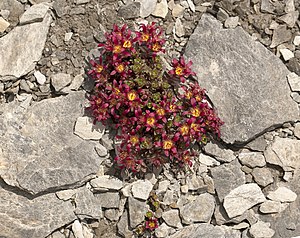Two-flowered saxifrage
| Two-flowered saxifrage | ||||||||||||
|---|---|---|---|---|---|---|---|---|---|---|---|---|

Two-flowered saxifrage ( Saxifraga biflora ) from the Bernese Alps (Switzerland) |
||||||||||||
| Systematics | ||||||||||||
|
||||||||||||
| Scientific name | ||||||||||||
| Saxifraga biflora | ||||||||||||
| Alles. |
The twoflower saxifrage ( Saxifraga biflora ) is a species in the genus saxifrage ( Saxifraga ) in the family Saxifragaceae (Saxifragaceae). It is a relatively rare, cushion-forming plant in the high Alps.
description
As an evergreen herbaceous plant, the two-flowered saxifrage forms loose cushions and, including the inflorescence, reaches heights of between 3 and 25 cm. The rungs are prostrate to ascending. The opposite arranged leaves are thick, with a diameter of no more than about 4 mm almost circular and also rounded at the tip and at most dotted. They become 5 to 9 mm long and 3 to 6 mm wide. They are sedentary and usually bear only a single hydathode on the top at the tip; underneath they are often red.
The flowering period extends from July to August. The dark purple flowers are two to six (up to eight) on a stem. The sepals are ciliate on the edge and 2 to 4 mm long. The stamens are shorter than the petals. The anthers are orange-yellow, rarely completely black. The petals are lanceolate to obovate, nailed short and broad, blunt or somewhat pointed, 4 to 10 mm long, purple-pink to violet, rarely white. The ovary is almost completely underneath with a broad disc. The fruit capsule is spherical and 4 to 6 mm long. The seeds are egg-shaped, 1 to 1.2 mm long and brown.
The species has chromosome number 2n = 26.
Distribution and location requirements
The two-flowered saxifrage occurs almost exclusively in the high altitudes of the central Alps ( Austria , Switzerland , Italy , France ). According to recent studies, information from the Allgäu relates to hybrids Saxifraga × kochii between Saxifraga biflora and Saxifraga oppositifolia .
There it seldom grows in moist fine rubble soils and prefers soils with little lime. It is a species of the Saxifragetum biflorae (association: Drabion hoppeanae).
The highest site is documented on the south ridge of the cathedral in the Mischabel group ( Valais ) at 4450 m.
Subspecies
There are three subspecies in Europe:
- Saxifraga biflora subsp. biflora
- Saxifraga biflora subsp. epirotica D.A. Webb : It occurs in north-western Greece near Timfi Oros.
- Saxifraga biflora subsp. macropetala (Engl.) Rouy & EG Camus (is also considered a variety Saxifraga biflora var. kochii Kittel ).
Sources and further information
literature
- Henning Haeupler , Thomas Muer: picture atlas of the fern and flowering plants of Germany (= the fern and flowering plants of Germany. Volume 2). Published by the Federal Agency for Nature Conservation. Ulmer, Stuttgart 2000, ISBN 3-8001-3364-4 .
- Werner Rothmaler : Excursion flora for the areas of the GDR and the FRG . Volume 2: Vascular Plants. 14th edition. People and knowledge, Berlin 1988, ISBN 3-06-012539-2 .
- Otto Schmeil , Jost Fitschen , Werner Rauh : Flora of Germany and its adjacent areas. 84th edition. Quelle & Meyer, Heidelberg 1968.
- Erich Oberdorfer : Plant-sociological excursion flora. Verlag Eugen Ulmer, Stuttgart 1994, ISBN 3-8252-1828-7 .
Individual evidence
- ↑ Jaakko Jalas, Juha Suominen, Raino Lampinen, Arto Kurtto: Atlas florae europaeae . Volume 12: Resedaceae to Platanaceae. Helsinki 1999, ISBN 951-9108-12-2 , p. 161.
- ↑ Dieter Hess: Alpine flowers. recognize, understand, protect . Ulmer, Stuttgart 2001, ISBN 3-8001-3243-5 , p. 189.
- ↑ a b D.A. Webb: Saxifraga L. In: Thomas Gaskell Tutin u. a .: Flora Europaea . 2nd Edition. Volume 1, pages 437-458. Cambridge University Press 1993. ISBN 0-521-41007-X
Web links
- Two-flowered saxifrage. In: FloraWeb.de.
- Profile and distribution map for Bavaria . In: Botanical Information Hub of Bavaria .
- Saxifraga biflora All. s. l. In: Info Flora , the national data and information center for Swiss flora . Retrieved November 1, 2015.
- Saxifraga biflora subsp. macropetala (Engl.) Rouy & EG Camus In: Info Flora , the national data and information center for Swiss flora . Retrieved November 1, 2015.
- Thomas Meyer: Data sheet with identification key and photos at Flora-de: Flora von Deutschland (old name of the website: Flowers in Swabia )
